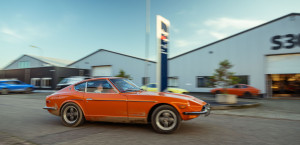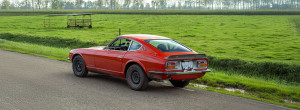There is no better way to describe it. But Alan would like to conclude by saying the following:
"So that was it. Four cars, all sightly different. A good cross-section, but - in my dreams - I would have liked to have some RHD export and (especially) Japanese Domestic models alongside to represent the whole "family" of early variants. Somehow I hope that there will be an opportunity for that in the future, but my mind is already made up, and my foremost thought is, HOW DID THEY DO IT?! The stylists, designers, engineers and all other staff involved in creating these cars got it SO right, and in SO little time. It is an amazing achievement. These cars have a modest and understated sophistication that I find all the more remarkable in light of the fact that they came from a Japanese manufacturer in the late 1960s. Amazing. I have so much admiration for the people in bringing these cars to the world market. Thank you!"
This trip was also something very special for Kats. And something educational. Miyzaki San was sitting in the passenger seat, who shared exciting details during the journey.
So let's read what he has to say:
"For me, it was the second time I had driven a Euro-spec car. The first time was almost 20 years ago in the UK in the right-hand drive HS30 "UK 240Z". I was so impressed with how well the car handled and accelerated. This time I had the same experience as with the red EU car. This last Euro-spec car was the best performing car on the road during our test.
What impressed me so much during this test drive was the word of Miyazaki San. He immediately noticed the driving characteristics after just a few meters of driving.
He said, "Ah, that's it! This car is a Euro version!"
Miyazaki San was sitting in the passenger seat, but as the S30's test and development engineer, he felt every single movement of the car. Miyazaki San was so enthusiastic the whole time that I told him he would love to drive the car and asked him to take turns. But Miyazaki San said, “I haven't driven for many years, so don't worry, I'll enjoy the test drive in the passenger seats.“
He remembers testing a front spoiler on the high-speed test track: the spoiler for these EU cars. The effect of the front spoiler is almost the same as that of the G-nose.
But why was the spoiler made of flexible urethane? And why was it so high?
Miyazaki San explained to me that it was because of its usefulness in the parking lot. The team considered the height of the tire stopper.
They needed information about how tall it was. They measured one in the Tomei highway parking lot, which had just opened when they were developing.
In addition, they received information from Europe on what the stopper looked like. And the risk of hitting the stopper was also taken into account. So it had to be flexible.
I noticed a small thing about which I felt something strange: the passing light and turn signal lever. My finger was something short to operate the lever. I found the lever is just like the Japanese S30 cars. For export cars, the steering wheel has a deep dish, which makes the lever a lot far from the steering.
So I was thinking the passing light and turn signal lever for export cars would have been angled to the steering wheel. However, it was not!
That was the only thing I felt strange. Other than that, it was an unforgettable moment for me. I remember Miyazaki San’s happy face."












